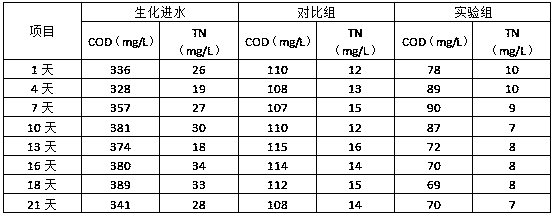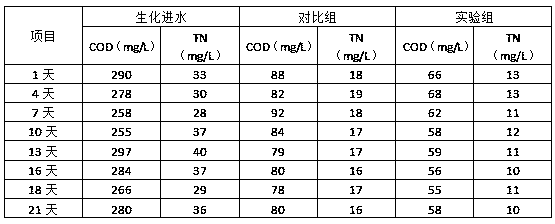Wastewater biochemical treatment denitrifying microorganism compound nutrition agent
A denitrifying microorganism and biochemical treatment technology, which is applied in the field of denitrifying microbial compound nutritional preparations for wastewater biochemical treatment, can solve the problems of inconvenient maintenance, single additional carbon source, and increased floor area, so as to reduce maintenance costs and technology Difficulty, the effect of increasing the footprint
- Summary
- Abstract
- Description
- Claims
- Application Information
AI Technical Summary
Problems solved by technology
Method used
Image
Examples
Embodiment 1
[0029] Wastewater biochemical treatment microbial compound nutrient solution, composed of the following raw materials by weight percentage: 19% glucose, 32% sucrose, 15% starch, 10% sodium acetate, 8% nitrogen nutrient, 6% phosphorus nutrient , 4% alkalinity regulator, 2% amino acid, 1% vitamin, 1% protease, 2% trace element additive.
Embodiment 2
[0031] Wastewater biochemical treatment microbial compound nutrient solution, composed of the following raw materials by weight percentage: 12% glucose, 33% sucrose, 23% starch, 6% sodium acetate, 12% nitrogen nutrient, 7% phosphorus nutrient , 2% alkalinity regulator, 2% amino acid, 1% vitamin, 1% protease, 1% trace element additive.
Embodiment 3
[0033] In a sewage treatment plant (circuit board industrial wastewater) in Huangpu District, Guangzhou, the influent CODcr of the wastewater biochemical treatment system is 328-389mg / L, the total nitrogen TN18-34mg / L, and PH6.8-7.3. There are 2 parallel sewage treatment systems in the factory, each with a treatment capacity of 1100 tons / day.
[0034] Comparison group: the nutrient solution is 20% by weight glucose-water solution;
[0035] Experimental group: the formula of embodiment 1 is dissolved into 20% by weight aqueous solution;
[0036] The dosage of nutrient solution in each sewage treatment system is 30 kg / day. After 21 days of cultivation and operation, the total nitrogen removal effect of the comparison group is not good, and the COD removal rate is not very good. The effluent COD is 102-115mg / L or so, the total nitrogen is 11-16mg / L; while the effluent COD of the experimental group is about 69-92mg / L and the total nitrogen is 7-10mg / L after 21 days of operation,...
PUM
 Login to View More
Login to View More Abstract
Description
Claims
Application Information
 Login to View More
Login to View More - Generate Ideas
- Intellectual Property
- Life Sciences
- Materials
- Tech Scout
- Unparalleled Data Quality
- Higher Quality Content
- 60% Fewer Hallucinations
Browse by: Latest US Patents, China's latest patents, Technical Efficacy Thesaurus, Application Domain, Technology Topic, Popular Technical Reports.
© 2025 PatSnap. All rights reserved.Legal|Privacy policy|Modern Slavery Act Transparency Statement|Sitemap|About US| Contact US: help@patsnap.com


